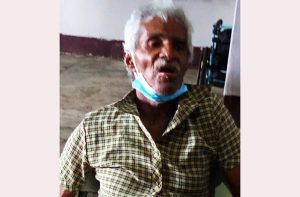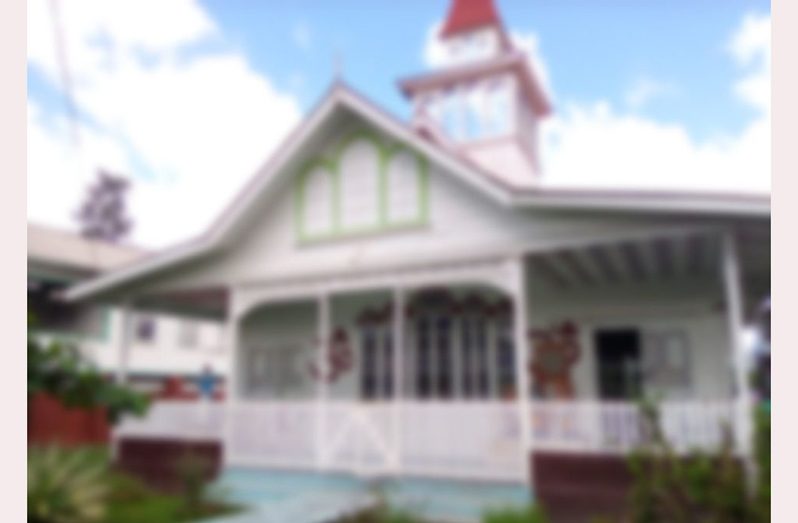-donations, vehicle needed
THE Dharm Shala, a home for the destitute, was birthed by the late Pandit Ramsaroop Maharaj, whose vision in 1940 was to address the needs of the poor, the sick and the homeless in Berbice. Consequently, at Garrison Road under the famous Canje Bridge in East Berbice and a short distance from the National Psychiatric Hospital, five buildings were erected through donations from individuals. The home was opened the following year by Governor of British Guiana, Sir Wilfred Jackson, L.C.M.G .
Initially, the bottom flat of the building was used as a school to address the education needs of children in the environs. Subsequently, the building was rebuilt and modernised by Pandit Mahahraj, who managed and maintained the facility until his demise. In 2013, the mantle of management was passed on to his daughters Kella and Pamela Ramsaroop.
A building erected on the precincts of the Dharm Shala houses a Hindu temple and an Anglican chapel and is the only local one of its kind. It was opened in 1942 by the then Governor of British Guiana, Sir Gordon Lethem, K.C.M.G., and is divided into two parts. One part houses the temple, and the other part an Anglican chapel, which met the religious needs of the residents of the home. The structure has since been given recognition by the National Trust of Guyana.
The caretaker, Gary Erskine, noted that it was the Anglicans who donated the land and it was a Hindu priest who erected the edifice. The Anglicans and the Dharm Shala coexisted and in honour of that relationship, the dual place of worship was erected, he said.
ALL ARE WELCOME

Over the years, the home has accommodated persons from China, Bangladesh, and Caribbean countries, Niger, Suriname and Colombia. It is the only home in the country where people from all walks of life and without any finance can live until they are back on their feet.
It once housed a Nigerian engineer who fell on “hard times” ; a doctor from Bangladesh who preferred to live amongst the “common people”; a national of China who was robbed of his earthly possessions, and other nationalities who were either passing through or had faced one of life’s many challenges.
It is also a place where family members “drop off” relatives without looking back. There are instances when sons dropped off their mothers, citing unresolved disagreements with wives or other relatives. No one visits these women.
There are other occupants whose immediate families are deceased and have left them with no other alternative but to seek refuge at the home. One resident was rescued from the cemetery and a female who was recovering from a mental illness was brought to the facility with only a not- working television and a bedside cupboard in her possession, after they were reportedly put out of the nearby National Psychiatric Hospital, where they were institutionalised.
There are other stories of children abandoning their parents. Some were evicted from their homes, while others received restraining orders from the court. They all sought and found refuge at the home which depends heavily on the benevolence of others.
Meanwhile, 72-year-old Eldon Bollers is the oldest inmate and he seldom walks unsupported.
According to him, he sustained an injury to his back while serving a sentence at the Camp Street Prison in Georgetown. He does not allow this physical challenge to restrict him from travelling around the township of New Amsterdam, where he could be overheard greeting passersby.
Bollers was unable to say when he entered the home, but recalled it was sometime after 1988 when he had completed serving a sentence for assaulting a peace officer. He has fathered three children and claims he has several grandchildren. The pensioner admitted his failure to keep in contact with his children and is unsure of their whereabouts.
Bollers expressed appreciation to his caregivers and the other residents of the home whom he said are his “family.”
BENEVOLENCE
Effective management of the home which currently houses 40 residents, is made possible through charity and donations from kind-hearted individuals.
Recently, Suresh and Bosy Ghamandi donated $100,000 in honour of their father who died a few months shy of his 100th birthday.
In addition to such kind-hearted persons, the Guyana Defence Force (GDF) has taken on the responsibility of ensuring that the home’s environment is maintained.
A medical observer recently told the Guyana Chronicle that the home needs a vehicle of its own to transfer residents to the New Amsterdam Hospital when they need to seek medical attention. Requests for vehicles to transport the sick are denied by officials because they are either on a transfer run or are out of the district. Many times, the elderly have to be taken to the hospital in a wheelchair, and sometimes those trips are detrimental.
The facility is currently being supervised by Dennis and Gary Erskine with the assistance of two females and several able-bodied residents.



.jpg)








